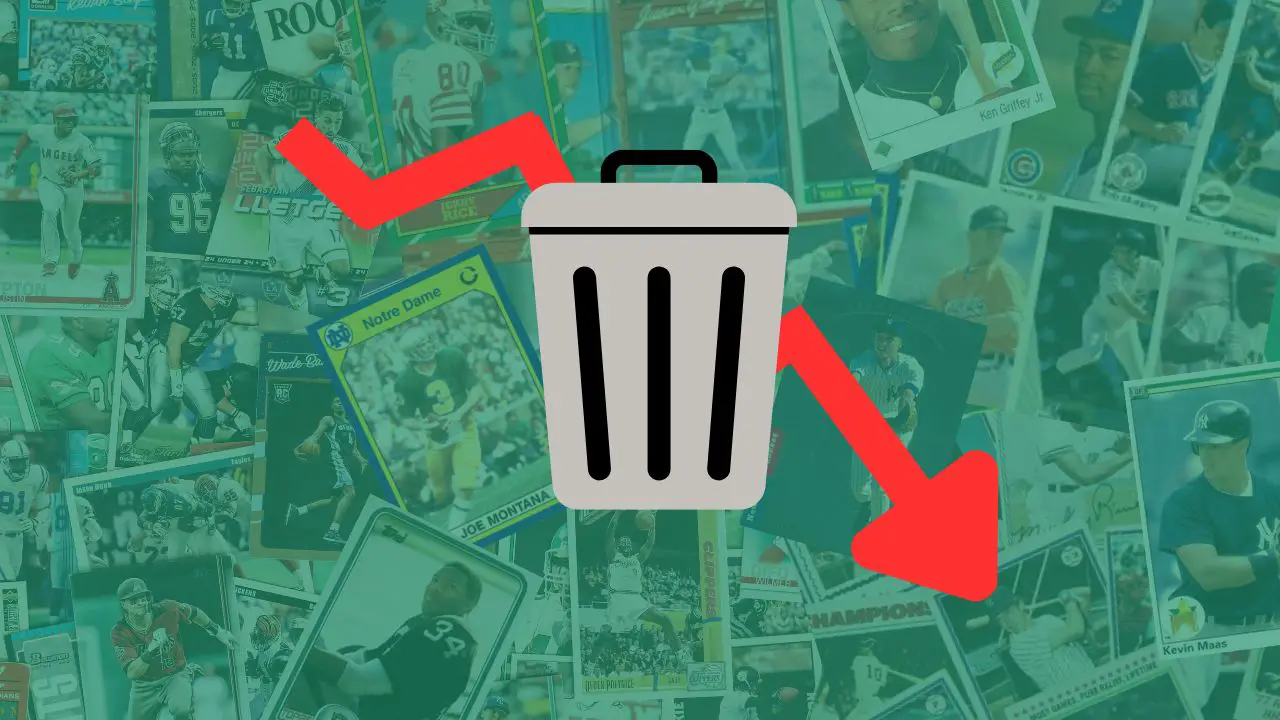
The sports card hobby experienced an unprecedented boom, and subsequent bust, during the late 1980s and early 1990s, leading to the overproduction of cards, and the tanking of card values.
This period, which is characterized by the excessive production of sports cards, is referred to as the ‘Junk Wax Era’.
Most sports cards from the 80s and 90s are worth very little as a result of that overproduction of cards.
Why was it called The Junk Wax Era? Well, the term ‘Junk Wax’ refers to the wax packaging in which cards were sealed, and the tanking of prices due to overproduction, making many of those cards ‘junk’ – Collectors coined the phrase as a name for the boom bust era of that time.
I’ve covered how the Junk Wax Era came about, what happened in the hobby during that time, and the legacy it has on the hobby today, below.
Table of Contents
The Junk Wax Era
When Was The Junk Wax Era?
The Junk Wax Era occurred during the late 1980s, into the early 1990s.
While the exact time frame is somewhat subjective, it’s generally considered that it started in 1986, and ended in 1993 (give or take a year either side).
What Caused The Junk Wax Era?
The popularity of sports card collecting, and the demand for cards, began to explode in the 1980s. Several factors contributed to the spike in interest, including the rise of cable television, which made sports more accessible to viewers.
The likes of Magic and MJ were lighting up the NBA, Ken Griffey Jnr in the MLB, plus Joe Montana and Jerry Rice in the NFL – Sports card mania arrived.
People started to believe that sports cards could only rise in value over time, so they were buying cards to hold, hoping to one day sell them for big profit.
Many different card manufacturers wanted in on the gold rush at the time, and started mass-producing cards to meet the demand, which was made possible because leagues were handing out licensing rights to pretty much anyone who wanted it.
New technology also allowed manufacturers to produce cards more efficiently and distribute them more widely.
Cards could be produced at a much lower cost than traditional printing methods, so that led to a lower barrier to entry, and therefore more manufacturers came into the sports card business.
What Happened During The Junk Wax Era?
So, we’ve established how the explosion of interest in sports cards came about; After that, way too many cards started getting produced, to the point where supply started to far outweigh the demand.
Once the hype and demand cooled, cards for even the world’s biggest sports stars at the time became easily accessible, and values fell sharply.
Manufacturers saw collectors were buying cards, and in turn overprinted them – The result? Most sports cards from the 80s and early 90s are effectively worthless, apart from a pick of a few key cards.
The quality of cards, and their design from that period, can also be questioned in many cases, due to the rush to get sets produced and cards on shelves.
What Is The Legacy Of The Junk Wax Era?
The Junk Wax Era serves as a cautionary reminder to both sports card manufacturers and collectors in the hobby today.
It was an era that almost collapsed the entire hobby, and proof that sports card values are bound to the laws of supply and demand.
Even in the hobby today, sealed wax from the Junk Wax Era doesn’t hold much value, despite it being 30+ years old.
There is the odd card which holds a bit of value from that period – One that will come to mind for many is the 1989 Upper Deck Ken Griffey Jr. (#1) card, which is arguably his most sought-after baseball card.
It’s easy to get hold of an ungraded version today, but a PSA 10 will set you back a couple of thousand dollars. It’s good for the period it’s from, but still much less than you’d pay for a top rookie today.
The decline of the sports card market in the mid-1990s led to a resurgence of interest in vintage cards from the pre-1980s era.
Collectors began to recognize the value of these cards, which were more scarce and rare than those produced during the Junk Wax Era.
While the sports card hobby has certainly seen renewed interest in modern times, with the growth of social media, access to online marketplaces, and increased popularity in sports betting, collectors and investors place more importance on scarcity.
Low numbered hits, parallels and inserts generally hold the most value; The hobby is a different place with the introduction of those types of card.
Final Thoughts
For many of us, sports cards from the Junk Wax Era is where it all started, so there’s definitely some nostalgia around the cards, and not all bad memories from the period.
However, card values from that time are never going to set any records, and the effect of overproduction in that era should be a lesson to those in the hobby, which will hopefully help avoid another Junk Wax Era.
In the hobby today, there’s potential value of sports cards as an alternative investment, provided that collectors and investors are careful to avoid the mistakes of the past.


